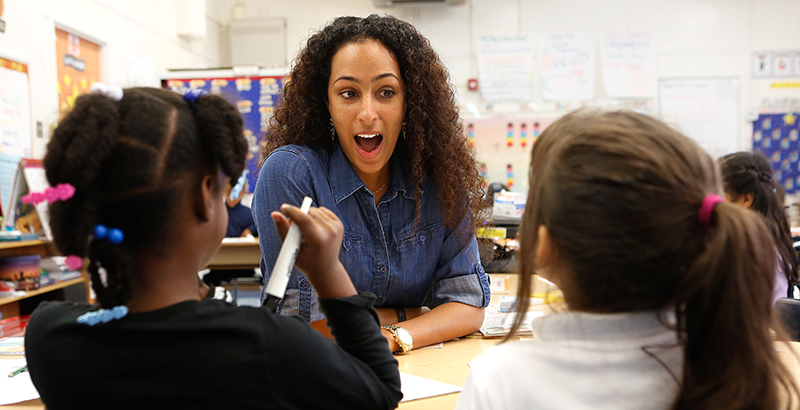For State Leaders Who Want Personalized Learning in Schools, New Report Shares 5 Ways to Support Teachers Through Policy

If state leaders want more student-driven learning in classrooms, creating policies that support teachers is critical.
That’s according to a new report from iNACOL, a nonprofit that supports competency-based education. The report outlines five recommendations for state policy leaders on how to help develop teachers so they’re prepared for competency-based instruction.
“We can talk about transforming the education system … but if we’re not addressing the capacity and buy-in of the people who themselves will be on the front lines of this work, then we will not succeed,” said Maria Worthen, vice president for federal and state policy at iNACOL.
The concept of allowing students to work at their own pace and progress once they’ve mastered a concept has gained popularity across the country from districts, states and philanthropists. Rhode Island, for example, created a statewide push for personalized learning, setting up innovation schools where educators can experiment with ideas like project-based learning.
However, these efforts aren’t without their challenges. In Maine, proficiency-based education efforts stalled partly because teachers were unsure how to grade students and parents were frustrated with a lack of clarity around grading. Additionally, there’s little research on the effectiveness of this kind of instruction.
For Worthen, the challenges and successes of competency-based efforts lie in how they are implemented. She said it’s important for all stakeholders to understand what they’re embarking on and why.
For state policy leaders, that means rethinking teacher credentialing, supporting diversity in the workforce and collaborating with a broad group of stakeholders. Here are iNACOL’s five recommendations to support this work.
1 Convene a state task force to craft a unifying vision and road map
This task force should include a diverse group of stakeholders who can collaborate on what they think good teaching looks like, the report recommends. This kind of instruction should match how the state hopes to prepare its high school graduates. It may be helpful for the group to create profiles of what their graduates will be able to do and in what ways their educators should be able to provide instruction.
The report points to Virginia as an example of this work. Virginia didn’t set out to create a competency-based model, but rather, to reimagine how it wanted to prepare its graduates. After many meetings, state leaders realized that they also wanted to better prepare their teachers for this work, so they crafted a profile of a Virginia teacher who could best support their ideal graduates. Doing this helped align things like higher education programs, teaching standards and licensing.
2 Increase the diversity of the educator workforce
State leaders can identify barriers that stand in the way of a diverse teaching workforce, such as high tuition bills and loan repayments. The report authors recommend tackling college affordability in both undergraduate and graduate school. Policymakers can interview leaders of teacher prep programs to find out what other barriers exist for would-be student teachers. Lawmakers can also use their bully pulpit to advocate for diversity in the teaching workforce as well as asking for data on teacher turnover for educators of color.
3 Prepare teachers for learner-centered, competency-based, equity-oriented education
Leaders can see if teacher prep programs and professional development are aligned with competency-based instruction. One way to do this is by funding innovation pilots for experimentation in learner-centered instruction. Policymakers can also support micro-credentialing for teachers, so that they can build knowledge and skills in personalized learning over time.
4 Redesign teacher licensure and credentialing
State leaders can rethink what skills are necessary for teacher licenses and credentials in order to teach personalized learning. These skills may include different ways of assessing students, designing lessons and working with students who are progressing at their own pace. Teacher credentials can be multi-tiered to demonstrate how educators are advancing in their skills.
5 Build balanced systems of assessments that enable learner-centered, competency based, equity-oriented teaching
Assessments can be a challenging part of competency-based learning, especially when schools allow for project-based or experiential learning where knowledge isn’t easily demonstrated by a multiple-choice test. The report recommends designing assessments that balance measuring growth and proficiency and that show whether a student is at or below grade level. Allowing for portfolios in addition to traditional exams will also demonstrate a broader range of skills that a student learned.
Disclosure: Carnegie Corporation of New York provides financial support to iNACOL and The 74.
Get stories like these delivered straight to your inbox. Sign up for The 74 Newsletter

;)
